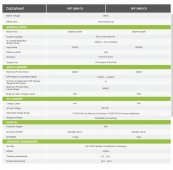Hi all,
Could someone look over a system I am trying to put together for an off grid property? I've watched many of 's videos, but I'd feel better if I had some feedback about the compatibility of the components, and I am also struggling to find the correct wire gauges.
I planned on using a Growatt 5000ES with two sets of panels in parallel, where each set is made up of eight 250watt panels in series. I have 4 lithium batteries, each 12V 100AH. I've included the data sheet for the Growatt. I was going to wire the batteries in series to make a 48V battery bank.
Some specs for the 16 panels:
Rated Power: 250W
Open circuit voltage (VOC): 37.6 V
Max power voltage (VMP): 30.3 V
Short circuit current (ISC): 8.85 A
Max power current: 8.27 A
Some specs for the batteries:
Charge Voltage: 14.6V
Max Charge Current: 50 A
Max Discharge Current: 100 A
The end of the array will be 43-45ft away from the Growatt and batteries. To the best of my knowledge I should use 8 gauge wire from the panels to the Growatt, and possibly 4 gauge between batteries? Any help would be appreciated.
Could someone look over a system I am trying to put together for an off grid property? I've watched many of 's videos, but I'd feel better if I had some feedback about the compatibility of the components, and I am also struggling to find the correct wire gauges.
I planned on using a Growatt 5000ES with two sets of panels in parallel, where each set is made up of eight 250watt panels in series. I have 4 lithium batteries, each 12V 100AH. I've included the data sheet for the Growatt. I was going to wire the batteries in series to make a 48V battery bank.
Some specs for the 16 panels:
Rated Power: 250W
Open circuit voltage (VOC): 37.6 V
Max power voltage (VMP): 30.3 V
Short circuit current (ISC): 8.85 A
Max power current: 8.27 A
Some specs for the batteries:
Charge Voltage: 14.6V
Max Charge Current: 50 A
Max Discharge Current: 100 A
The end of the array will be 43-45ft away from the Growatt and batteries. To the best of my knowledge I should use 8 gauge wire from the panels to the Growatt, and possibly 4 gauge between batteries? Any help would be appreciated.
Attachments
Last edited:






